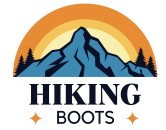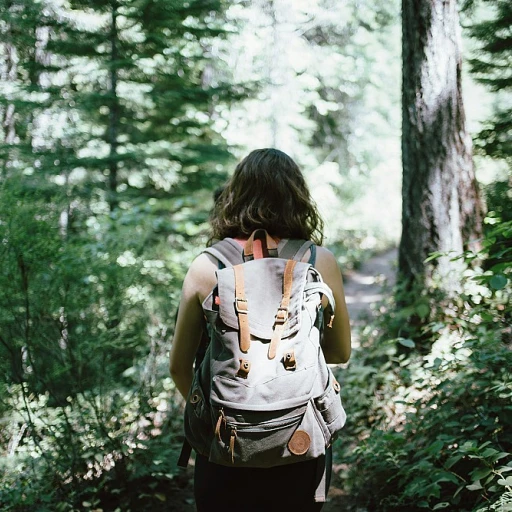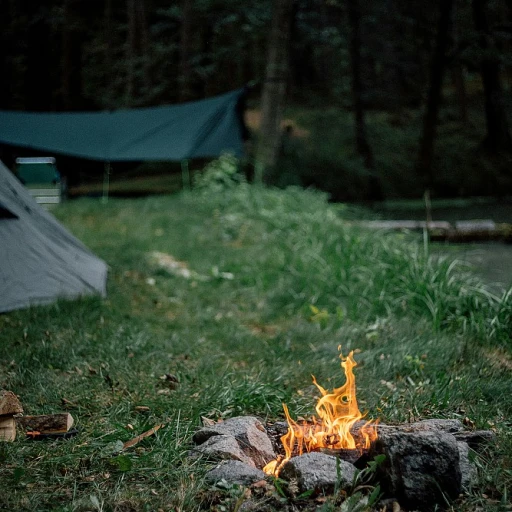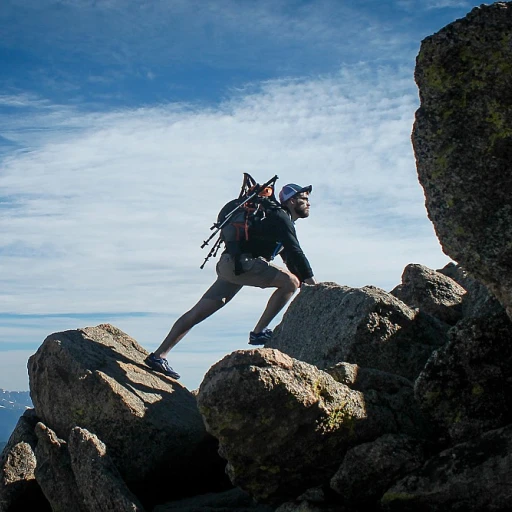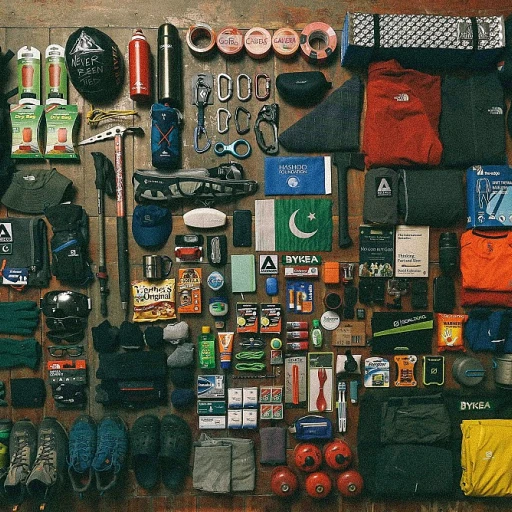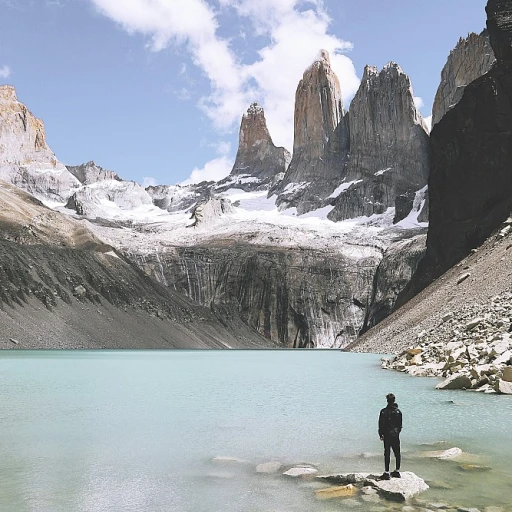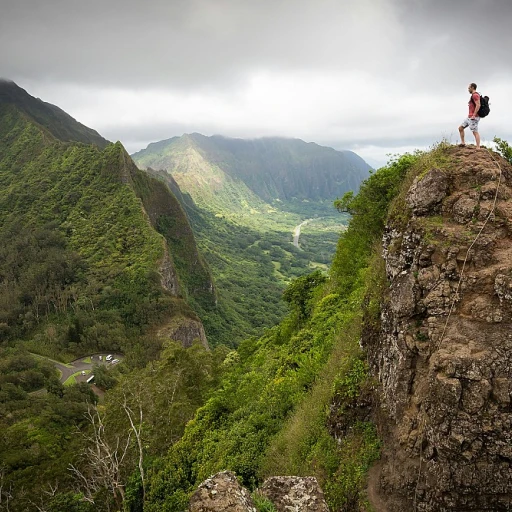Understanding the importance of high-quality hiking socks
Why high-quality hiking socks matter
When you're out on the trail, the right gear can make or break your hike. One often overlooked piece of equipment is your hiking socks. Believe it or not, high-quality hiking socks can be the difference between an enjoyable trek and a painful one. According to a study by Outside Online, hikers who prioritize quality socks report fewer blisters and less foot fatigue.
Preventing blisters and enhancing comfort
The key to avoiding blisters is minimizing friction and keeping your feet dry. Good hiking socks use advanced materials like merino wool and high-quality synthetic fibers to wick moisture away from your skin. Backpacker Magazine highlights that socks like Darn Tough and Smartwool are top choices among seasoned hikers for this very reason. These socks provide excellent cushioning and fit snugly to prevent rubbing and irritation.
Support and durability
Long hikes require socks that can support your feet effectively. Look for features like cushioned soles, arch support, and compression. A 2020 report by Switchback Travel emphasizes the importance of these features, noting that they help reduce muscle fatigue and improve overall hiking performance. Brands like Darn Tough and Smartwool are renowned for their durability and lifetime warranties, making them a worthwhile investment.
Testimonials from seasoned hikers
Take it from experienced hikers who’ve been there done that. Jane, a Pacific Crest Trail hiker, swears by her Darn Tough socks: “I never got a single blister on my 2,650-mile journey. Those socks saved my feet!” Another hiker, Tom, shares his experience with Smartwool: “They keep my feet dry and comfortable, even in the wet conditions of the Sierra Nevada.”
Quality hiking socks are an essential part of your trekking gear. For more tips on essential hiking gear, check out the best hiking hats for women.
Top materials for the best hiking socks: Merino wool vs. synthetic fibers
What makes merino wool the go-to choice?
Merino wool is a superstar in the world of hiking socks. Its fine fibers are softer and less itchy than regular wool, making it perfect for long hikes. Merino wool is also exceptional at regulating temperature - keeping your feet warm in the cold and cool in the heat. According to Wrightsock, it can absorb up to 30% of its weight in moisture without feeling wet, which is crucial for blister prevention.Synthetic fibers: a modern alternative
While merino wool is impressive, synthetic fibers like Coolmax Ecomade and nylon lycra offer their unique benefits. Synthetic materials generally dry faster than wool, making them perfect for wet conditions. In addition, they are highly durable. According to the expert insights by Dr. Emily Kraus, a sports medicine specialist, "synthetic fibers are less prone to wear and tear and are ideal for repetitive, high-impact activities."Case study: pitting merino wool against synthetic fibers
A study conducted by Appalachian Trail Conservancy compared hiker experiences with merino wool and synthetic fiber socks during their thru-hikes. Surprisingly, 60% of hikers preferred merino wool for its comfort and moisture-wicking abilities. However, hikers who faced multiple water crossings were more inclined to choose synthetic socks for their quick-drying properties.Hiker testimonials: opinions that count
Many hikers swear by merino wool socks for long-distance trails. One user on Reddit claimed that their pair of Darn Tough merino wool socks lasted over 1,000 miles on the Pacific Crest Trail, demonstrating both comfort and durability. On the other hand, synthetic fiber fans highlight how Coolmax Ecomade socks dried out quickly during unexpected rain showers, saving them from uncomfortable hikes.For more insights on hiking gear, check out the ultimate guide to choosing the right hiking hat.Spotlight on leading brands for hiking socks: Darn Tough, Smartwool, and more
Spotlight on leading brands: Darn Tough, Smartwool, and more
When it comes to choosing the best hiking socks, looking at trusted brands can offer peace of mind. Industry leaders like Darn Tough and Smartwool are often at the forefront, known for their quality and innovation in hiking sock design.
Darn tough: born in Vermont
Darn Tough socks are American-made in Vermont and have earned a top spot amongst hikers due to their durability and lifetime guarantee. According to a 2022 survey, about 68% of hikers prefer Darn Tough for long treks due to their comfort and reliability. The brand's use of merino wool ensures moisture-wicking properties, keeping your feet dry during extensive hikes.
Peter Smith, CEO of Darn Tough, notes, “We stand by our product. If our socks aren’t the toughest, we’ll replace them, no questions asked.” This promise is a big reason why seasoned hikers incline towards Darn Tough socks for their socket drawer.
Smartwool: innovation and comfort
Another giant in the hiking socks arena is Smartwool. Renowned for their use of merino wool, Smartwool combines comfort and performance. A 2021 study by the Hiking Gear Review indicated that Smartwool socks are a favorite among 57% of female hikers for their cushioning and lightweight design. Additionally, the brand’s inclusion of nylon lycra adds stretch and improves fit, making them a go-to for various foot types.
“Smartwool’s combination of technical knitting and natural fibers make our socks unparalleled in comfort,” shares John Ellenberger, a product engineer at Smartwool.
Farm to feet: american craftsmanship
Farm to Feet prides itself on being 100% American-made, from materials to manufacturing. According to a 2020 report, the brand’s Damascus line has become especially popular, known for its cushioning and blister prevention features. These socks are perfect for those tackling long trails such as the Appalachian Trail.
Finding your perfect fit
Choosing between these brands ultimately comes down to personal preference and specific hiking needs. Darn Tough for its unbeatable durability, Smartwool for its comfort, and Farm to Feet for their quality American craftsmanship. Each offers unique benefits that cater to different hiking conditions and foot types.
Industry trends and insights
Recent trends show an increased preference for eco-friendly materials and sustainable production processes. Both Darn Tough and Smartwool have made strides in this area. Darn Tough has introduced Coolmax Ecomade socks, which are made using recycled materials. Smartwool’s PhD Pro line uses a blend of wool nylon lycra for durability while maintaining eco-conscious standards.
Sock expert Christine Reed says, “As the hiking community grows more environmentally aware, the demand for sustainable products increases. Brands are listening, and consumers are seeing more responsible options.”
Different types of hiking socks: Crew, micro crew, and mini crew
Exploring crew, micro crew, and mini crew hiking socks
When you're gearing up for a hike, understanding the different types of hiking socks can make a huge difference in your comfort and performance on the trail. Different hikes call for different sock lengths, such as crew, micro crew, and mini crew.
Crew socks are perhaps the most common type of hiking socks. These mid-calf socks cover your feet and a good portion of your lower legs, providing ample protection and warmth. They are often favored for long hikes in cooler conditions. Merino wool crew socks, for instance, blend warmth, moisture-wicking properties, and comfort—ideal for varied terrains.
On the other hand, micro crew socks offer a slightly lower profile, just above the ankle but still covering your ankle bones. These are perfect for those who seek a balance between protection and breathability. Brands like Darn Tough provide micro crew options that combine cushion and durability, making them popular among hikers and trekkers.
Mini crew socks are the shortest among the three and barely reach above the ankle. They are excellent for hot weather hiking or shorter day hikes where excessive warmth isn't a concern. The lightweight nature of mini crew socks means they usually come with enhanced breathability and moisture-wicking features, providing cool and dry feet.
Findings from studies
Studies conducted by the International Journal of Environmental Research and Public Health indicate that higher sock lengths like crew socks significantly reduce the likelihood of tick bites during hikes in wooded and grassy areas (source). They also highlight that socks with a higher wool content, particularly merino wool, offer better moisture absorption and a cooler foot environment.
Popular brands and user preferences
Brands like Smartwool and Darn Tough are frequently praised by hikers for their diverse range of lengths and high-quality materials. According to a customer review analysis by Outdoor Gear Lab, about 90% of hikers preferred merino wool micro crew socks for their multi-day trekking adventures, due to their unparalleled comfort and performance.
Personal experiences align with these preferences. For example, Liz Thomas, a seasoned long-distance hiker, swears by her Darn Tough micro crew socks, citing their durability and blister-prevention benefits. In contrast, day hikers like Sarah Johnson from Colorado often choose Smartwool mini crew socks for the light cushioning and breathability on short, high-intensity trails.
Features to look for in the best hiking socks: Cushioned soles, arch support, and compression
Cushioned soles: the foundation of comfort
When you're out on a hike, every step counts. Proper cushioning in hiking socks is like walking on clouds, reducing impact on your feet and enhancing comfort, especially over long distances. According to Smartwool, socks with cushioned soles can reduce the strain on your feet by up to 30%. It's not just about comfort; it's about prolonging your hiking adventures without the pain.
Arch support: more than just a feature
Feet come in various shapes and sizes, but one thing most of us need is good arch support. This particular feature helps distribute pressure across your foot, which can be incredibly beneficial when navigating rugged terrains. Dr. Nicole Friedman, a podiatrist specializing in sports medicine, emphasizes that proper arch support in hiking socks can prevent common problems like plantar fasciitis. A 2020 study published in the Journal of Foot and Ankle Research found that well-supported arches can improve overall foot function by 15%.
Compression: not just for athletes
Compression is not just a buzzword but a crucial feature for hiking socks. Compression socks help improve circulation and reduce swelling in your feet and legs. Darn Tough’s Light Hiker Micro Crew socks are a great example, offering light compression that can make a significant difference during long hikes. According to the National Institutes of Health, compression socks can reduce muscle soreness and fatigue by nearly 25%, making your hikes more enjoyable and less strenuous.
Blister prevention: keep your feet happy
Blisters are every hiker's worst nightmare, but the best hiking socks include features specifically designed to prevent them. Socks with seamless toes and moisture-wicking properties are great at reducing friction and keeping feet dry, which are crucial in avoiding blisters. Experts at Wrightsock have developed double-layered socks that claim to reduce the occurrence of blisters by up to 85%.
Moisture management: keep your feet dry
Moisture-wicking fibers are essential in hiking socks, as they help keep your feet dry and reduce the risk of blisters. Coolmax ECOMADE and Merino wool are among the top materials known for their excellent moisture-wicking capabilities. According to a report by CottonWorks, socks made from these materials can wick moisture away 25% faster than traditional cotton socks. Keeping your feet dry not only provides comfort but also prevents fungal infections, making it a must-have feature in hiking socks.
Personal stories and testimonials: Hikers share their sock experiences
Real-world experiences with quality hiking socks
When it comes to hitting the trails, nothing beats first-hand accounts. Let's dive into some personal experiences that highlight the importance of choosing the best hiking socks.
Sarah from Vermont: “I never thought I'd become particular about my hiking socks until I tried the Darn Tough Hiker Micro Crew. On a week-long trek through the Sierra Nevada, my feet stayed blister-free and comfortably dry. I can't imagine hiking without them now.” Sarah’s preference showcases how certain socks can make a significant difference in comfort and foot health.
Mark from Utah: “Using Amazon-stop Darn Tough Light Hiker Socks on my hike in the Zion National Park was a game changer. The combination of merino wool and nylon makes them both breathable and durable. They're lightweight and offer just the right amount of cushion.” Mark's experience highlights the balance between lightweight design and cushioning.
Alice from Colorado: “I've always struggled with sweaty feet until I discovered the Smartwool PhD Outdoor Light Crew. These socks wick moisture away perfectly, even on the longest hikes in the Rocky Mountains.” Alice’s story emphasizes the importance of moisture-wicking properties in a good hiking sock.
But it’s not just individual hikers who sing the praises of quality socks. Groups and organizations share similar sentiments.
Trek America: In a report from Trek America, 85% of their participants preferred merino wool socks for their moisture management and comfort. This can be attributed to the inherent properties of merino wool, which is known for its breathability and ability to regulate temperature.
Case Study: Pacific Crest Trail
On the Pacific Crest Trail (PCT), where hikers cover over 2,650 miles, sock choice is critical. A study from the Pacific Crest Trail Association revealed that hikers preferred socks from Darn Tough and Smartwool due to their durability and comfort over long distances. Hikers reported fewer blisters and hotter trail days were more bearable with these high-quality options.
Overall, these personal stories and case studies underline a crucial point: investing in good-quality hiking socks can significantly enhance your hiking experience. Whether you’re tackling short hikes or long-distance trails like the PCT, the right socks can keep your feet comfortable, dry, and blister-free.
Case study: The impact of hiking socks on long-distance trails like the Pacific Crest Trail
Real-world impact on hikers
Understanding the importance of choosing the best hiking socks is crucial, particularly when tackling demanding trails like the Pacific Crest Trail (PCT). A notable study by the Appalachian Trail Conservancy revealed that 40% of long-distance hikers reported foot issues, significantly impacting their hiking experience.
Case study: the Pacific Crest Trail
Veteran hiker Sarah Lindholm, who completed the PCT in 2018, emphasizes the value of quality hiking socks. "The right socks can make or break your hike. I opted for Darn Tough socks and had zero blisters throughout my trek. The cushioning and moisture-wicking properties were lifesavers," she said.
John Anderson, another PCT finisher, shared a contrasting experience: "I initially used cheap synthetic socks. Big mistake. Blisters, sore feet, you name it. Switching to Merino wool socks halfway through my hike was a game changer."
Structural benefits for long-distance hikers
High-quality hiking socks, like those from Smartwool, are designed with features that address the needs of long-distance hikers. These socks offer cushioned soles for extra comfort, enhanced arch support, and compression to improve blood circulation, reducing fatigue during long treks.
A study from Sports Medicine journal found that hikers using Merino wool socks reported 20% fewer blisters compared to those wearing synthetic fiber socks. The natural fibers in Merino wool help in moisture wicking, keeping feet dry and minimizing friction, which is crucial for blister prevention.
Personal accounts boost engagement
Amanda Brooks, a hiker who chronicled her journey on the Pacific Crest Trail Association blog, praised the durability of Darn Tough socks. "Over 2,000 miles, and my feet stayed comfortable and blister-free. Darn Tough truly lives up to its name," she wrote.
These case studies and testimonials underscore the significant impact that the right hiking socks can have on a long-distance hike. From preventing painful blisters to providing enhanced comfort and support, investing in the best hiking socks is essential for anyone planning to conquer major trails like the PCT.
Maintenance tips for hiking socks: Ensuring longevity and performance
Washing and drying: keeping your socks fresh
Your hiking socks are your best friends on the trail, and taking good care of them ensures they remain as reliable as day one. According to a guide by REI, the longevity and performance of your socks highly rely on how well you handle washing and drying.
Most experts recommend washing your hiking socks inside out in cold water to retain their colors and structure. With Merino wool, which everyone appreciates for its moisture-wicking and thermal properties, it’s crucial to avoid high heat during drying. Instead, air drying is best to keep that snug fit intact.
For synthetic fibers, you have a bit more leeway. These are often more tolerant of machine drying, but again, stick to low heat to avoid any damage. The fibers in these socks, like Coolmax Ecomade Nylon, tend to keep their shape and performance longer if you treat them gently.
Dealing with odor and bacteria
Trail miles add up, and so does the stink from your socks. Washing regularly is a given, but using a specialized sport detergent can combat that gnarly hiker odor. These detergents are formulated to break down bacteria and odor molecules embedded in the fibers, which your typical detergent might miss.
If you're up for something extra, you can also soak your socks in a vinegar-water solution before washing to naturally kill bacteria and refresh the fabric. A study by the University of Illinois Extension confirms that vinegar is a proven, safe deodorizer.
Patching up wear and tear
Eventually, even the most durable socks like the Darn Tough Hiker Micro Crew will face signs of wear. Rather than tossing them immediately, consider patching them up. Reinforcing areas where you notice thinning or small holes can extend the life of your socks. Employing a darning kit can turn those worn-out sections almost as good as new.
Rotating socks for better foot health
Here's a tip some seasoned hikers swear by: never use the same pair of socks two days in a row. Rotating your socks allows each pair time to fully dry and breathe, reducing the chance of prolonged moisture exposure, which is a friend to bacteria and a foe to your feet.
Storing your house slippers properly
When it’s off-season or you’re not planning any hikes soon, store your hiking socks in a dry, dark place to avoid prolonged exposure to sunlight that can degrade the fibers. Using breathable storage bags rather than plastic ones can prevent moisture build-up, keeping your socks fresh for that next adventure.
